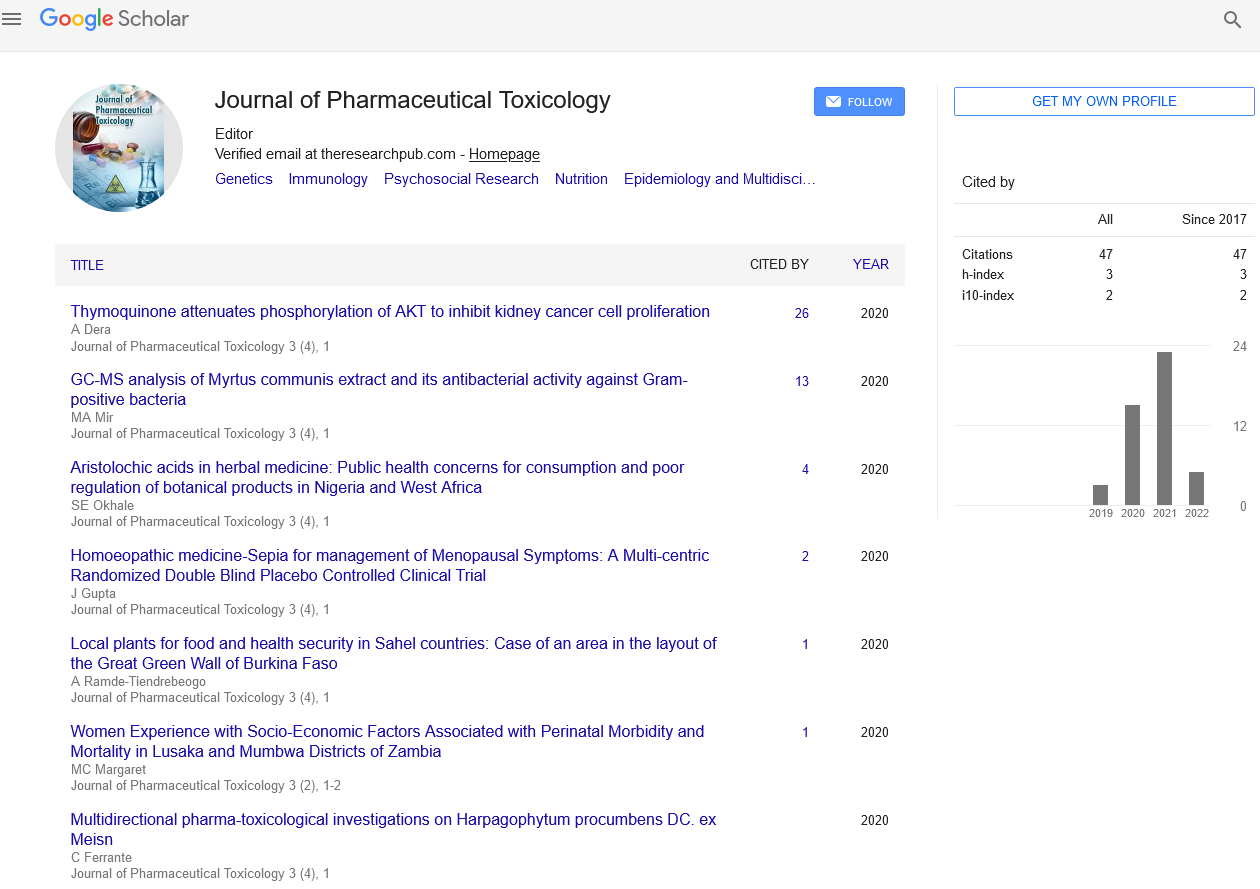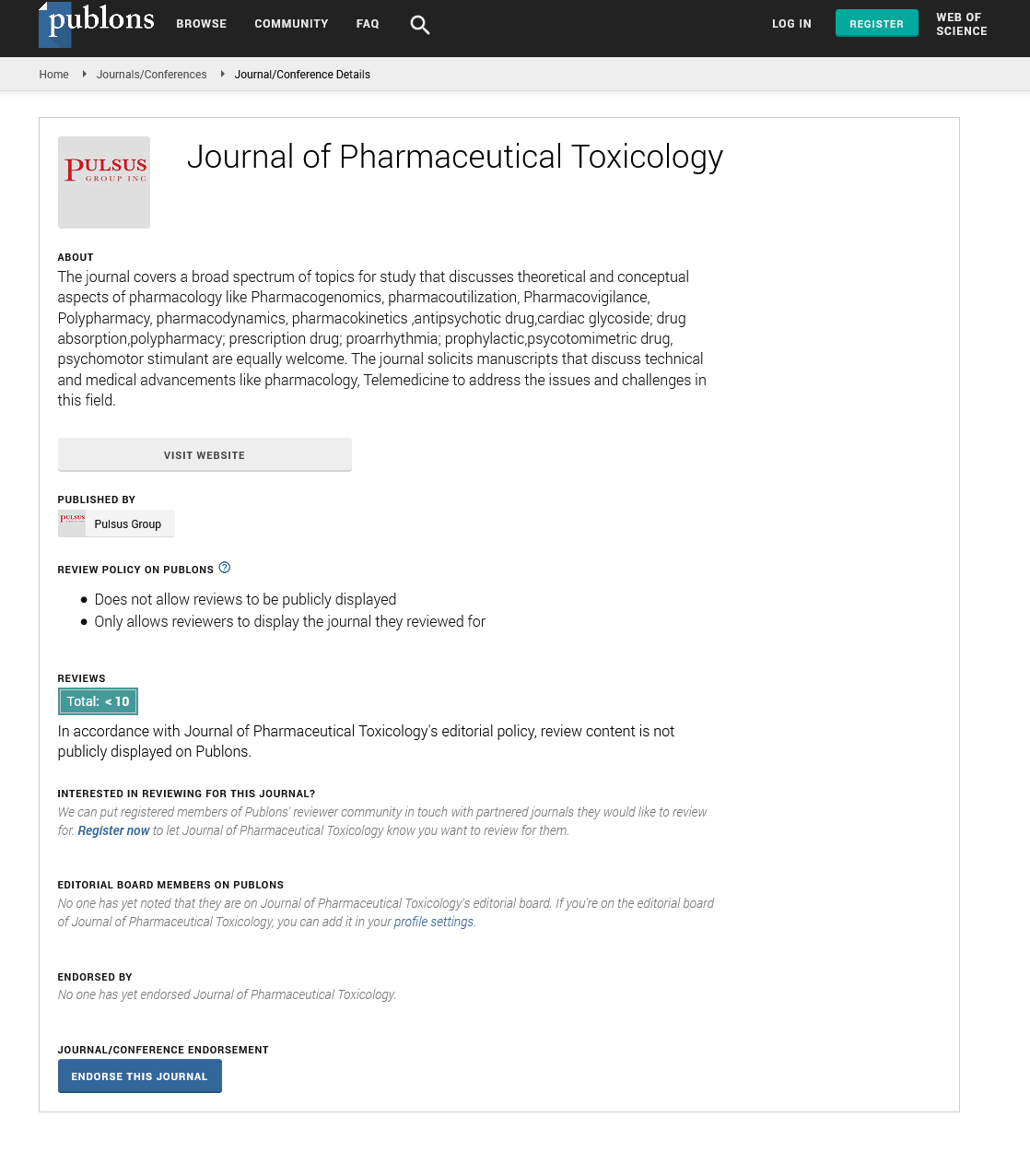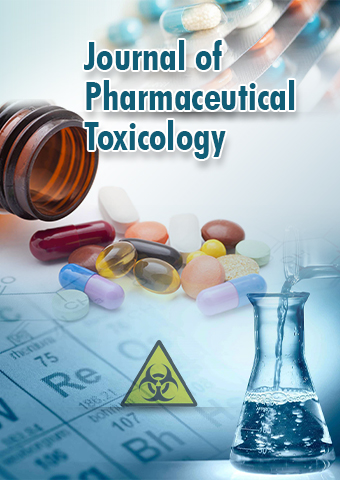Research Article - Journal of Pharmaceutical Toxicology (2023) Volume 6, Issue 4
Pharmaceuticals Refer to a Category of Medical Products That are Designed to Diagnose
Asif Khan*
Department of Pharmacy, King Saud University, Saudi Arabia
Department of Pharmacy, King Saud University, Saudi Arabia
E-mail: asif@gmail.com
Received: 01-August-2023, Manuscript No. oajpt-23-108597; Editor assigned: 3- August -2023, PreQC No. oajpt-23-108597 (PQ); Reviewed: 17- August -2023, QC No. oajpt-23-108597; Revised: 22- August -2023, Manuscript No. oajpt-23-108597 (R); Published: 28- August -2023; DOI: 10.37532/ jpt.2023.6(4).128-131
Abstract
Pharmaceuticals, also known as drugs or medications, are substances or compounds developed and used for medical purposes. They are designed to diagnose, treat, prevent, or alleviate various medical conditions, diseases, or disorders in humans and animals. The pharmaceutical industry plays a crucial role in advancing healthcare by researching, developing, producing, and distributing these medicines. The process of developing a pharmaceutical product involves extensive research and testing. Scientists and researchers explore various chemical compounds, natural substances, or biologics to identify potential therapeutic effects. These compounds undergo pre-clinical studies to assess their safety and efficacy before moving to clinical trials. Clinical Trials: Pharmaceutical companies conduct clinical trials to evaluate the safety, effectiveness, and appropriate dosage of the drug in human volunteers or patients. These trials are typically conducted in multiple phases, starting with a small group and progressing to larger populations. Regulatory authorities closely monitor and review the trial data to ensure the drug’s safety and efficacy before approval for marketing.
Introduction
Pharmaceuticals can be classified into different categories based on their uses and properties, including are medications available without a prescription and are generally used for common ailments like headaches, colds, and allergies. These medicines require a doctor’s prescription and are used for more complex or serious conditions, such as chronic diseases or infections. Generic Drugs: Once the patent of a brand-name drug expires, other manufacturers can produce generic versions with the same active ingredients, dosage, and effectiveness. These are complex pharmaceutical products derived from living organisms, such as proteins or cells, used to treat various diseases like cancer, autoimmune disorders, and rare genetic conditions.
Drug approval and regulation: Pharmaceutical products must undergo rigorous evaluation by regulatory agencies, such as the Food and Drug Administration (FDA) in the United States or the European Medicines Agency (EMA) in Europe. These agencies assess the safety, quality, and efficacy of drugs before granting approval for marketing and distribution.
Drug distribution and use: Once a pharmaceutical product receives regulatory approval, it is manufactured, packaged, and distributed to healthcare providers, pharmacies, and hospitals. Doctors prescribe the appropriate medications based on a patient’s diagnosis and medical history [1-3].
Adverse effects and side effects: While pharmaceuticals are designed to be beneficial, they can also have adverse effects and side effects. These may range from mild reactions like drowsiness or upset stomach to more severe complications, which is why proper dosing and monitoring are essential. Overall, pharmaceuticals have revolutionized modern medicine, significantly improving the quality of life for many people and contributing to the prevention and treatment of various illnesses. However, responsible use, adherence to prescribed dosages, and regular communication with healthcare professionals are vital to ensure the safe and effective use of pharmaceuticals. Pharmaceuticals, also known as drugs or medicines, are substances used to diagnose, treat, prevent, or alleviate the symptoms of diseases and medical conditions in humans and animals.
These substances are developed through rigorous scientific research and are regulated by health authorities to ensure their safety, efficacy, and quality. The pharmaceutical industry plays a crucial role in healthcare, as it is responsible for the discovery, development, manufacturing, and distribution of medications. The process of creating a new pharmaceutical typically involves several stages [4-6].
Discussion
Research and discovery: Scientists identify potential drug candidates by studying the underlying causes of diseases and exploring new molecules or compounds that could have therapeutic effects. This stage often involves extensive laboratory research and screening of thousands of compounds. Promising drug candidates undergo preclinical testing in cell cultures and animal models to evaluate their safety, effectiveness, and potential side effects. These studies help researchers understand how the drug interacts with living systems.
Clinical trials: If a drug candidate shows promise in preclinical studies, it proceeds to clinical trials. Clinical trials involve testing the drug on human volunteers to determine its safety, efficacy, dosage, and potential side effects. The trials are conducted in several phases, with an increasing number of participants and more stringent testing protocols in each phase.
Regulatory approval: After successful clinical trials, pharmaceutical companies submit the drug’s data to regulatory agencies, such as the U.S. Food and Drug Administration (FDA) in the United States or the European Medicines Agency (EMA) in Europe. These agencies review the data to ensure the drug’s safety and efficacy before granting approval for marketing and distribution.
Manufacturing: Once approved, the pharmaceutical company scales up production to manufacture the drug in large quantities while maintaining strict quality control measures to ensure consistency and safety.
Distribution and marketing: The pharmaceutical product is distributed to pharmacies, hospitals, and other healthcare facilities. Extensive marketing and educational campaigns are often conducted to inform healthcare professionals and patients about the drug’s benefits, usage, and potential side effects.
Post-marketing surveillance: After a drug is released to the market, its safety and efficacy are continually monitored through post-marketing surveillance. This involves tracking adverse reactions and collecting data on the drug’s realworld effectiveness in diverse patient populations [7,8].
Pharmaceuticals encompass a wide range of products, including prescription drugs, overthe- counter medications, vaccines, biologics (medicines derived from living organisms), and various therapies for different medical conditions. It’s essential to use pharmaceuticals responsibly and as directed by healthcare professionals, as improper use or abuse can lead to adverse effects or reduced effectiveness. Additionally, ongoing research and development in the pharmaceutical industry aim to discover new and improved treatments for existing and emerging medical challenges. Pharmaceuticals refer to drugs or medications that are used to diagnose, treat, prevent, or alleviate medical conditions and diseases in humans and animals. These drugs are typically developed through extensive research and testing to ensure their safety and efficacy before they are approved for use by regulatory authorities.
Researchers identify potential drug compounds that may have therapeutic effects by studying biological processes and disease pathways. This stage often involves computer-based modeling, high-throughput screening, and testing on cellular or animal models. Promising drug candidates undergo preclinical testing in laboratories and animal models to assess their safety, pharmacokinetics (how the body absorbs, distributes, metabolizes, and excretes the drug), and potential side effects. This stage helps researchers identify the most viable candidates for further development.
Clinical trials: If a drug candidate passes the preclinical stage, it enters clinical trials. Clinical trials are conducted in three or four phases involving human volunteers. Phase I trials focus on safety and dosage, Phase II evaluates the drug’s efficacy and side effects in a larger group, Phase III involves a larger patient population to confirm results, and Phase IV occurs after approval and involves post-marketing surveillance.
Regulatory approval: Once clinical trials demonstrate safety and efficacy, pharmaceutical companies submit a New Drug Application (NDA) or equivalent to regulatory agencies like the U.S. Food and Drug Administration (FDA) or the European Medicines Agency (EMA).If approved, the drug can be marketed and prescribed for specific medical conditions.
Manufacturing: After approval, pharmaceutical companies scale up production to meet demand while adhering to strict quality control and manufacturing standards.
Post-Marketing surveillance: Even after a drug is approved and in use, pharmaceutical companies and regulatory agencies continue to monitor its safety and effectiveness in real-world settings through post-marketing surveillance. Pharmaceuticals cover a wide range of products, including prescription drugs, over-the-counter medications, vaccines, biologics, and more. They play a critical role in healthcare, helping to improve and extend the lives of millions of people worldwide. However, they must be used responsibly and under the guidance of healthcare professionals to ensure their proper and safe application.
Pharmaceuticals refer to a category of medical products that are designed to diagnose, treat, prevent, or manage diseases and health conditions in humans and animals. These products are commonly known as drugs or medications and play a crucial role in modern healthcare. Pharmaceuticals can be either chemical or biological in nature, and they undergo rigorous research, development, testing, and approval processes before they are made available for use by the public.
Research and development: Pharmaceutical companies invest significant resources in research and development to discover and develop new drugs. This involves identifying potential drug targets, conducting preclinical studies, and running clinical trials to assess safety and efficacy in humans.
Regulatory approval: Before a pharmaceutical can be marketed and sold to the public, it must receive regulatory approval from health authorities such as the U.S. Food and Drug Administration (FDA) in the United States or the European Medicines Agency (EMA) in Europe. This process involves a thorough evaluation of the drug’s safety and effectiveness based on the results of clinical trials.
Distribution and marketing: Once approved, pharmaceuticals are distributed to pharmacies, hospitals, and healthcare providers. Pharmaceutical companies engage in marketing and educational efforts to inform healthcare professionals and the public about the drugs’ benefits and risks [9,10].
Conclusion
Drug safety and monitoring: Even after approval, pharmaceuticals continue to be monitored for safety and potential adverse effects. Healthcare professionals and patients are encouraged to report any adverse reactions to the regulatory authorities.
Patents and generics: Pharmaceuticals are often protected by patents, giving the original developer exclusive rights to produce and sell the drug for a certain period. Once the patent expires, other companies can produce generic versions, usually at a lower cost.
Importance in healthcare: Pharmaceuticals have played a critical role in extending and improving the quality of life for countless individuals by treating various illnesses, preventing diseases, and managing chronic conditions. It is essential to use pharmaceuticals responsibly and under the guidance of healthcare professionals to ensure their safe and effective use. Additionally, ongoing research and development in the pharmaceutical industry contribute to advancements in medicine and healthcare practices.
References
- Van den Anker J, Reed MD, Allegaert K et al. Developmental Changes in Pharmacokinetics and Pharmacodynamics.J Clin Pharmacol.58, 10-25 (2018).
- Aagaard L. Off-Label and Unlicensed Prescribing of Medicines in Paediatric Populations: Occurrence and Safety Aspects. Clin Pharmacol Toxicol.117, 215–218(2015).
- Gore R, Chugh PK, Tripathi CD. Pediatric Off-Label and Unlicensed Drug Use and Its Implications.Curr Clin Pharmacol.12, 18–25 (2018).
- Sketris, IS. American Geriatrics Society Beers Criteria®Update Expert Panel. American Geriatrics Society 2019 Updated AGS Beers Criteria®for Potentially Inappropriate Medication Use in Older Adults.J Am Geriatr Soc.67, 674–694 (2019).
- Hill-Taylor B, Walsh KA, Stewart S et al. Effectiveness of the STOPP/START (Screening Tool of Older Persons’ potentially inappropriate Prescriptions/Screening Tool to Alert doctors to the Right Treatment) criteria: Systematic review and meta-analysis of randomized controlled studies.JClin PharmTher.41, 158–169 (2016).
- Tommelein E, Mehuys E, Petrovic M et al. Potentially inappropriate prescribing in community-dwelling older people across Europe: A systematic literature review.Eur J Clin Pharmacol.71, 1415–1427.
- Prot-Labarthe S, Weil T, Angoulvant F et al. POPI (Pediatrics: Omission of Prescriptions and Inappropriate prescriptions): Development of a tool to identify inappropriate prescribing.PLoS ONE.9,25-68.
- Corrick F, Conroy S, Sammons H et al. Paediatric Rational Prescribing: A Systematic Review of Assessment Tools.Int J Environ Res Public Health.17, 1473-1496 (2015).
- Sadozai L, Sable S, Le E Roux et al. International consensus validation of the POPI tool (Pediatrics: Omission of Prescriptions and Inappropriate prescriptions) to identify inappropriate prescribing in pediatrics.PLoS ONE.15, 47-72 (2018).
- Barry E, Moriarty F, Boland F et al. The PIPc Study-application of indicators of potentially inappropriate prescribing in children (PIPc) to a national prescribing database in Ireland: A cross-sectional prevalence study.BMJ Open.8, 69-556 (2019).
Indexed at, Google Scholar, Crossref
Indexed at, Google Scholar, Crossref
Indexed at, Google Scholar, Crossref
Indexed at, Google Scholar, Crossref
Indexed at, Google Scholar, Crossref
Indexed at, Google Scholar, Crossref


